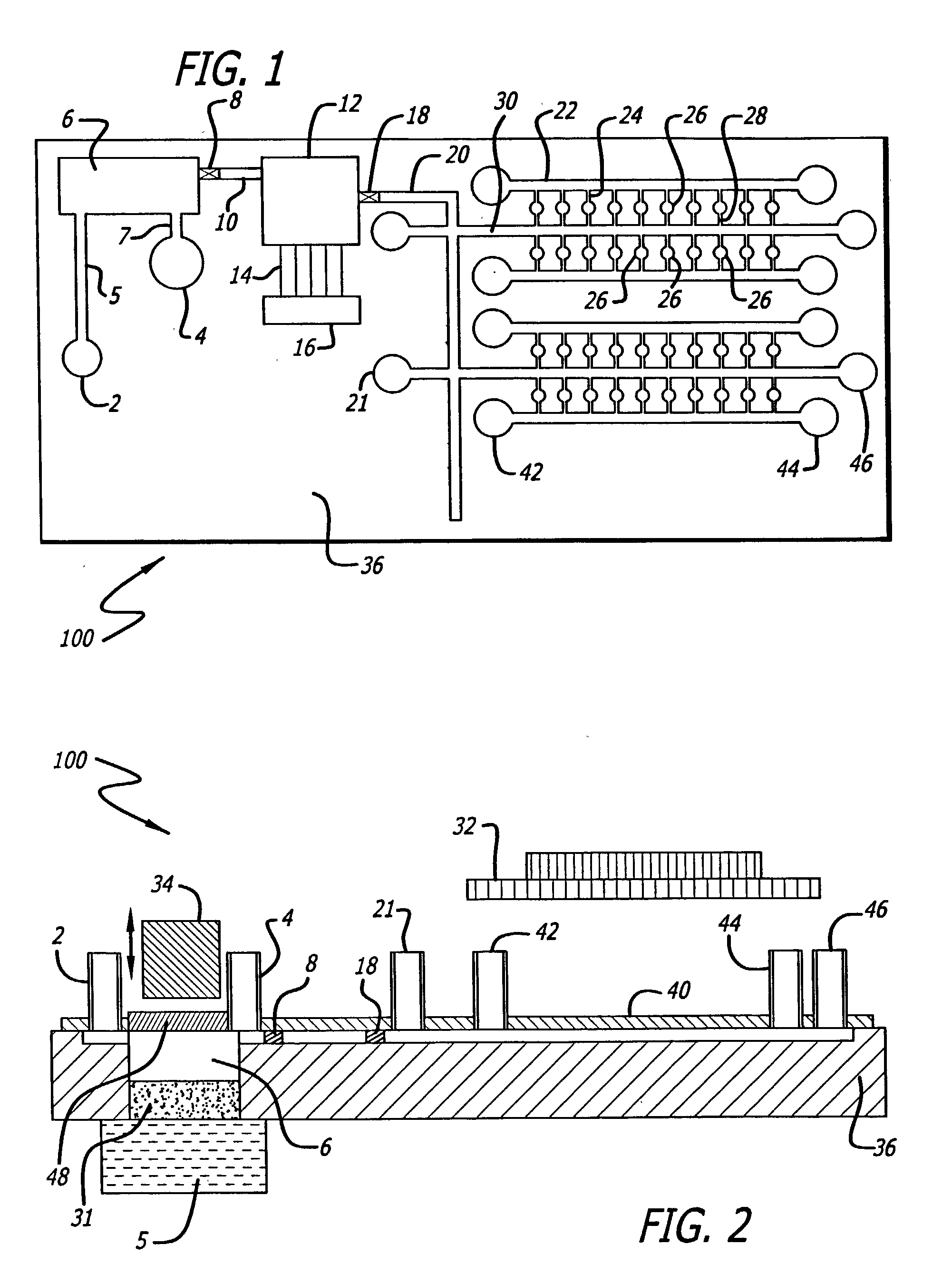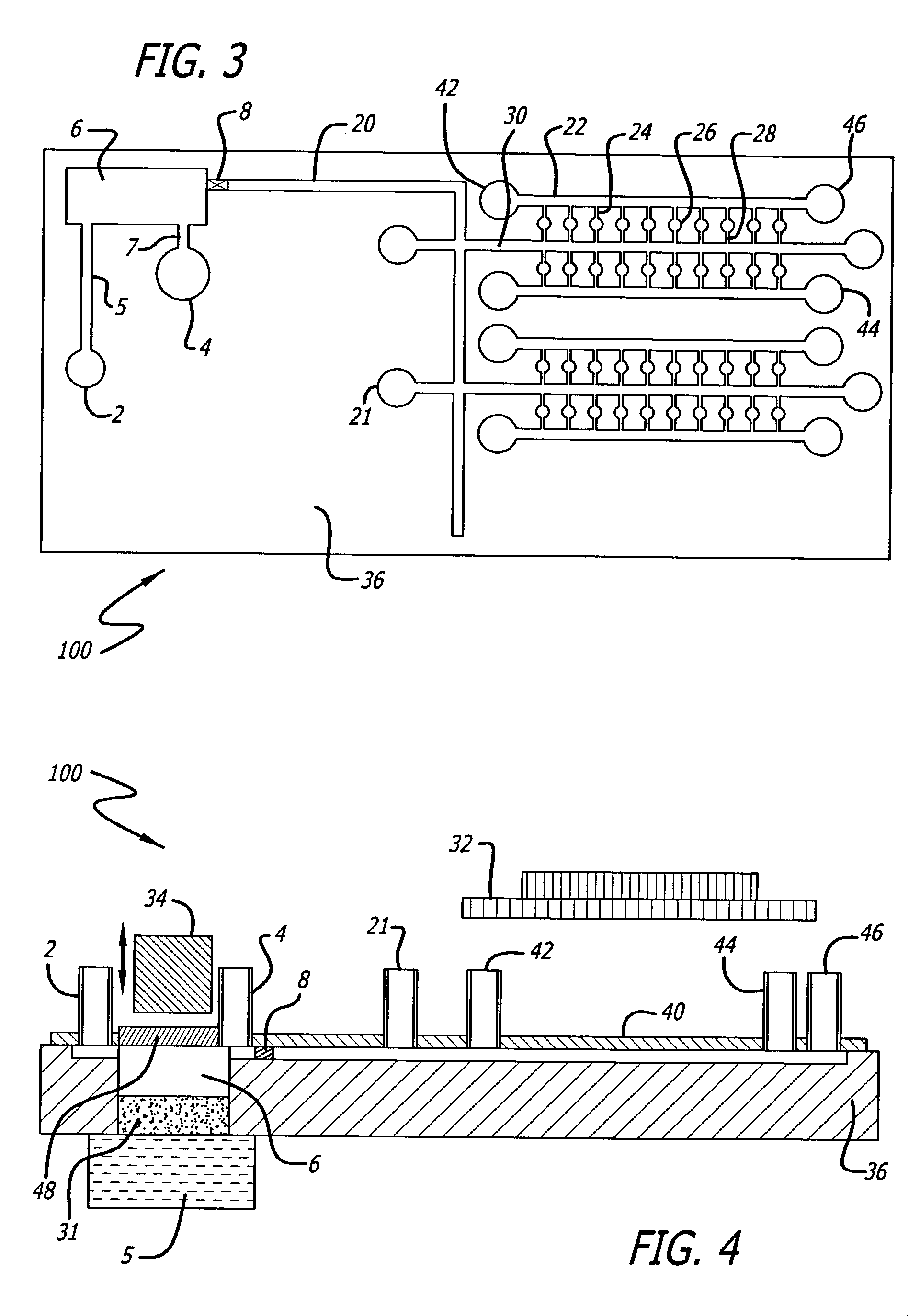Sample preparation integrated chip
- Summary
- Abstract
- Description
- Claims
- Application Information
AI Technical Summary
Benefits of technology
Problems solved by technology
Method used
Image
Examples
example 1
[0220] Antibody-antigen fluorescence quenching assay: An antibody was labeled with OG-514 (Oregon green 514 carboxylic acid, succinimidyl esters) and the antigen (peptide, protein, whole cells, carbohydrate, aptamers, etc.) was labeled with QSY-7 (QSY-7 carboxylic acid, succinimidyl esters). Fluorescence quenching prevented or suppressed the detection of OG-514 fluorescence. The labeled antibody-antigen complex was lyophilized in the assay stations. Sample fluid preparation releases proteins or other antigens into PBS or TBS buffer with or without detergent (e.g. Tw-20 or Triton-X 100) of various concentration (e.g. 0.05% Tw-20 and 1%Triton-X-100), and flow into the assay station(s) via channels. Upon re-hydration in the assay station, the labeled antibody-antigen complex participates in competitive reaction with the unlabeled antigen. Competition with unlabeled antigen releases the OG-514 labeled antibody whose fluorescence is detected at about 528-530 nm.
example 2
Double Sandwich Antibody FRET
[0221] Two monoclonal antibodies directed against 2 non-competitive epitopes of the CD8-alpha chain were utilized. One of the monoclonals was labeled with the dye phycoerythrin (PE) and the other allophycocyanin (APC).
[0222] FRET was observed when excitation light was directed to PE but the efficiency was only 10%. Reference: Batard P., et.al., Cytometry Jun. 1, 2002;48(2):97-105. The efficiency of FRET may be improved by using near Infra-red FRET dye pairs such as the squaraine dyes (Sq635 and Sq660). Reference: Oswald B. et. al., Analytical Biochemistry 280, 272-277 (2000).
example 3
[0223] Re-association of recombinant antibody light and heavy chain directed by a bridging antigen (open sandwich assay).
[0224] Recombinant antibody anti-HEL (Hen egg lysozyme) fragment heavy chain (VH) and light chain (VL) were labeled with succinimide esters of fluorescein and rhodamine-X, respectively. The weak affinity of VH and VL towards each other prevent association and FRET, but at low temperature e.g. about 4C and in the presence of antigen, the VH and VL interactions stabilized and hence FRET occurred. When excited at 490 nm, significant decrease in the fluorescence at 520 nm and its increase at 605 nm were observed when an increasing amount of HEL (antigen) was added to the mixture in the concentration range of 1-100 micrograms / ml. Reference: Ueda H et. al., Biotechniques Oct. 1999;27(4):738-42.
[0225] A modification of the above method may be utilized as follows. Instead of labeling with fluorescent dyes such as fluorescein and rhodamine, chimeric protein of VH--Rluc (Re...
PUM
| Property | Measurement | Unit |
|---|---|---|
| Time | aaaaa | aaaaa |
| Temperature | aaaaa | aaaaa |
| Flow rate | aaaaa | aaaaa |
Abstract
Description
Claims
Application Information
 Login to View More
Login to View More - R&D
- Intellectual Property
- Life Sciences
- Materials
- Tech Scout
- Unparalleled Data Quality
- Higher Quality Content
- 60% Fewer Hallucinations
Browse by: Latest US Patents, China's latest patents, Technical Efficacy Thesaurus, Application Domain, Technology Topic, Popular Technical Reports.
© 2025 PatSnap. All rights reserved.Legal|Privacy policy|Modern Slavery Act Transparency Statement|Sitemap|About US| Contact US: help@patsnap.com



